Report on miscellaneous cotton insects in Texas . h on the caudal portion, the change in color gradually extend-ing forward. At the same time the pruinosity is lost, and finally theadults become shining blackish. The color of the immature stages isexceedingly variable. THE FALSE CHINCH BUG.[Nysius angustatus Uhl. Fig. 15.) During the spring of ltK)4 the false chinch bug occurred in unusualnumbers over widely separated localities in Texas and Louisiana, dam-aging all sorts of crops, many of them not heretofore known to beinjured by it. and among them cotton. Attention was first called to its oc

Image details
Contributor:
The Reading Room / Alamy Stock PhotoImage ID:
2AN1DX9File size:
7.2 MB (253.1 KB Compressed download)Releases:
Model - no | Property - noDo I need a release?Dimensions:
1732 x 1443 px | 29.3 x 24.4 cm | 11.5 x 9.6 inches | 150dpiMore information:
This image is a public domain image, which means either that copyright has expired in the image or the copyright holder has waived their copyright. Alamy charges you a fee for access to the high resolution copy of the image.
This image could have imperfections as it’s either historical or reportage.
Report on miscellaneous cotton insects in Texas . h on the caudal portion, the change in color gradually extend-ing forward. At the same time the pruinosity is lost, and finally theadults become shining blackish. The color of the immature stages isexceedingly variable. THE FALSE CHINCH BUG.[Nysius angustatus Uhl. Fig. 15.) During the spring of ltK)4 the false chinch bug occurred in unusualnumbers over widely separated localities in Texas and Louisiana, dam-aging all sorts of crops, many of them not heretofore known to beinjured by it. and among them cotton. Attention was first called to its occurrence by the citizens oH Sabinal.Uvalde County, Tex., late in April; and on May *2 Mr. Sanborn visitedtin1 locality. The insect had been known there for several years, butuntil that spring had never done serious damage. The young bugsoccurred at that time in countless numbers, having caused the mesquitetrees to turn yellow, and destroyed the young cotton so as to necessi-tate replanting over large areas, more or less injury occurring over the. 30 MISCELLANEOUS COTTON INSECTS. territory within a radius of 10 miles from Sabinal. The migrationof the bugs was much like that of the true chinch bug (Blissus leucop-terus Sa}^); they would remain in one place until the vegetation therewas destroyed and then move on. At this time hardly anv adultbugs were seen. Late in May the writer visited the same fields, andhardly a specimen could be secured, although a few adults were foundin corn. In this case the damage was done entirely by the nymphs;and the swarms disappeared after their devastation of the cotton assuddenly as they had appeared. Of the nymphs taken to the labora-tory all died before maturing, so that their identity can not be definitelyestablished; but there seems to be no doubt, from a comparison withdetermined specimens, that they are Nysius angustatus. Early in May the same species appeared in immense numbers inwheat fields in one or two localities in north Texas, greatly